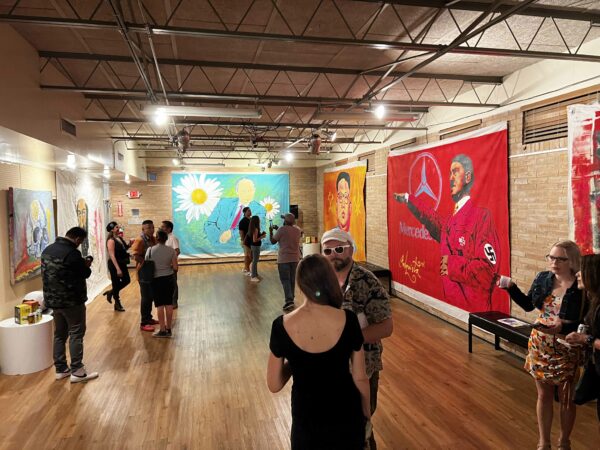It’s late one April evening at the Phoenix Gallery in downtown McAllen, Texas. Magdiel Castle is loading his sculptures into the space for an upcoming group exhibition curated by gallery director and artist Uriel Landeros. The two are discussing the orientation of a sculpture while I examine a painting hung on one of the gallery’s walls. “That’s Henry David Potwin,” Landeros says, “he went to art school with Julian Schnabel.” Potwin and Schnabel both studied art at the University of Houston during the early 1970s. It was while studying art at the same school in 2012 that Landeros began his own art career with headlines in the New York Times, CNN, and the BBC after using a stencil to spray paint the image of a bullfighter, a bull, and the word “Conquista,” the Spanish word for conquest, on Pablo Picasso’s 1929 painting Woman in a Red Armchair at the Menil Collection.
Initially interested in working as a teacher after graduating from college, Landeros began to question his career path after hearing a professor complain about the quality of work in Houston museums. “That kind of stuck with me, you know. I’m going to be a frustrated teacher who wants to be an artist. Is that really what I want to do with my life? That moment changed me.” Landeros was heavily involved with graffiti at the time, painting messages of “peace and unity” on bridges and trains throughout Houston. “The helicopter would come out from the news and document the graffiti that I had written. Then I would go to class in the morning and everybody was talking about what I painted. I would just get high with that.”
While ambitions grew for a wider audience to share his ideas with, it wasn’t clear exactly what those ideas were. “I came from a barrio on the outskirts of Edinburg, called La Colonia Muniz,” Landeros explains, “the roads were not paved and half the houses are little trailers. I became the first person in my neighborhood to go to college, and I always felt like I owed something to my community.” Drawing further from his experiences as an Indigenous Mexican American raised in South Texas, he continued, “in my history class they would teach us about the story of Christopher Columbus. It was always like, look at this conquistador, he’s bringing Christianity and killing all the colored people here. I always hated that story because they’re killing the people that look like me.”
Landeros came to associate the Spanish artist Pablo Picasso with the conquistadors that colonized the Americas in the 15th century. However, that association was not as black and white as one might think. “Picasso is a genius. The greatest artist that ever lived. One of his greatest quotes is ‘good artists borrow, great artists steal.’ He appropriated images from African culture into his painting. Every artist has stolen,” Landeros says.
So it followed that on June 13th, 2012, Landeros entered the Menil Collection in Houston and defaced Picasso’s Woman in a Red Armchair. It’s worth noting that Picasso himself is alleged to have painted over an artwork by Italian artist Amedeo Modigliani , and there is some precedent with other similar artistic actions, i.e Rauschenberg’s Erased de Kooning Drawing and, most notably, Tony Shafrazi’s spray painting of Picasso’s 1937 painting Guernica. Reactions to Landeros’ act were mixed, with the Museo De Arte Carrillo Gil in Mexico City rewarding the artist with a spot in a group show, while Menil Collection Director Josef Helfenstein said “it threatened the public’s ability to enjoy a wonderful painting and violated the bonds of trust that enable museums to share great works with their visitors.”
Some writers sought out and lavished praise on the artist while others, including The Wall Street Journal’s Eric Felten, suggesting that “the gatekeepers of artistic fame might want to reconsider rewarding alleged art vandals with portfolio reviews.” For his part, Landeros dedicated the action to “all the people out there who have suffered for any injustice of every kind. To those abused by their loved ones. For those abused by their government. For those who were abused by organized religion. And to Picasso, from artist to artist. The beast is meant to be conquered. Picasso loved bullfighting because he knew at the end of the dance, someone had to die and on that day it was his turn.”
About six months after his encounter with Picasso at the Menil, Landeros was arrested by the Hidalgo County Sheriff’s Office. Charged with criminal mischief and felony graffiti, he was sentenced soon after to two years in prison. Despite being housed in “maximum security” facilities, he received packages with supplies, art books, and magazines from family and was able to continue working as an artist. Some of his fellow inmates, including those imprisoned for murder and other more serious crimes, found it hard to believe that the young artist was locked up in the same prison as them for graffiti. Landeros recalled another prisoner’s reaction upon learning of his charges: “If you’re lying, if you did something heinous, we’re going to find out.” However, Landeros’ story checked out. “I really didn’t want to affiliate with a lot of people in there, but they did ask me if I knew how to tattoo. I didn’t, but what I ended up doing was selling drawings. And then there was somebody there who would tattoo them.” Ultimately, he was able to complete hundreds of drawings and paintings during his time in prison.
After his release in 2014, Landeros returned to Houston to complete the final semester of his art degree at the University of Houston. To help make ends meet he found work creating giant styrofoam sculptures for a local grocery store, “fruits and vegetables mainly. Fish for the seafood section, bulls’ heads for the meat section.” Graduating after a few months, a return to the Rio Grande Valley in South Texas soon followed.
While Landeros was in prison, his father had been in contact with a priest at Resurrection Catholic Church in Alamo, Texas. The family had attended the church throughout Landeros childhood, and now the priest was looking for someone to create a mural for their chapel. “That’s one of my greatest projects. It’s like the Sistine Chapel, but the characters are Mexican, you know, or brown skinned. I got to paint Jesus brown,” the artist says. In the ensuing years, Landeros focused on creating commissioned murals for schools throughout South Texas, and has continued to show in galleries and stage exhibitions of performance art. For one such performance, he was filmed being branded on the chest with a scalding hot iron that spelled out the word “ART.”
In May 2022, Landeros exhibited a series of original paintings at the McAllen Creative Incubator. The Disruptors featured portraits of seven controversial public figures, including Vladimir Putin, Christopher Columbus, and Adolf Hitler. Unsurprisingly, reactions to the work were polarized. Speaking at the exhibition opening, Landeros explained his reasoning behind framing Putin with a vibrant blue background and bright pink tie, flanked by white daisies. “I wanted to make the piece a little bit approachable, since it’s a very sensitive subject. I think the colors that I picked are very attractive. And I wanted to just kind of balance out the situation, that way people could actually approach it and talk about it and not be scared to show how they feel or express themselves.”
A portrait of Osama Bin Laden in neutral tones and featuring two pink figures suggestive of the twin towers is juxtaposed with one of George Washington in blackface. “Bin Laden is a hero to some people. As Americans, we’re criticizing Russia and all these other countries. But this country is founded in slavery and death and the Trail of Tears. So who are we to say, who’s the bad guy?” Landeros acknowledges that statements like these are provocative, but pushes back against the idea that he might be painting reprehensible figures in a sympathetic light, “it’s not about appreciation, not commemoration. I’m just pointing out what everyones thinking. My job as an artist is to create questions. Put the subject in people’s faces and let them have the conversation.”
Back at the Phoenix Gallery in McAllen, artworks by Julian Schnabel, Andy Warhol, Banksy, and Tony Shafrazi are being prepared. Landeros plans to modify them for one of his future exhibits. “I already painted over a Dali. I’m using master as my medium.” However, unlike the Picasso at the Menil, Landeros owns these works, having purchased them from Swedish gallerist Börge Bengtsson. Before continuing work on the project, Landeros is planning a trip to Monterrey, Mexico. He’s working on a film about his life with filmmakers Joshua Moroles and Robert Espericueta, and they plan to film a bullfight there for the opening scene. It’s unclear what the critical consensus to Landeros new works will be, but he’s certain to continue generating a lively debate.






11 comments
Brown people enslaved brown people as well, this guy is a joke. Using identity politics in order to make your work more “interesting” is the problem with the art world and writing pieces like this. Also the fact the I have met this joke of a person before and literally only cares about money and not all this “conquering” of the West over marginalized people. He’s not changing anything in the system or even starting a dialogue. This makes white people think he’s exotic and just buy his random paintings. This is all just virtue signaling.
Picasso painted over a Modigliani painting that he owned. The two artists were friends. Johns erased a de Kooning that de Kooning gave him knowing in advance what Johns’ plan for it was. Of the three examples Michael Flanagan gives of similar acts to Landeros’ painting over a Picasso, two are completely spurious. What Landeros did (and what Shafrazi did) were simply wrong. Morally and legally wrong. Any attempt to excuse this act is absurd. And no one does, as far as I can determine. The only defenders that Flanagan mentions are the proverbial “some writers”. That is the weakest appeal to authority possible. Landeros went to jail, deservedly. About his paintings of people like Hitler and Osama Bin Laden, he was quoted in a publication called “Texas Border Business”: “I painted these figures in large scale to reflect their power and dominance in world history, as well as in current times,” said Conquista. “The lion doesn’t ask to be a lion. He just is. And in the same way, these men did not ask to be who they were. For better or worse, it was their destiny.” I’m sorry–if he actually said this, he just sounds dumb.
This hack may have been interesting if the idea to spraypaint over the Picasso had even been his, but it wasn’t. His “friend” James put him up to it and pretended to be a bystander for interviews with the local news. Uriel is untalented and James took advantage of him.
Absolutely his “friend James” took advantage of him. “James” hosted an art show for Uriel after all this happened , just so it could bring notoriety and publicity for himself (NYT article and photo) and his joke of an art gallery. “James” biggest claim to fame was riding the wave of chaos that he created.
Uriel was just a pawn in this sick person’s game.
You could have written about so many other Houston artists but you chose this clown…
My impression is that many of the folks critiquing this artist Uriel in the comments have no familiarity with art history, globally or as it pertains to Houston. The Menil collection features many artworks which, when you trace their history—were bought from dealers who acquired them as stolen artifacts from the African diaspora and works confiscated from Jewish families during the Holocaust.
This article does not mention this history but that is another layer of context to Uriel’s graffitied “conquest.”
You do not have to agree with Uriel’s vandalism of the Picasso piece, but there is no need to pretend that the Menil is a sacred institution. Additionally, while Uriel did deface another artists legacy piece—that should not have earned him such a harsh prison sentence. To say he deserved prison for making a radical artistic gesture is fascistic and cruel.
Congrats to Uriel and all the rebel artists pushing back against the rigid boundaries of an overwhelmingly white art world.
so much wrong with this article/attitude. Aside from the religious hypocrisy the individual succumbs to, this individual reeks of the “poor pitiful me” syndrome. Unless you were born entitled, we are all in this (world) together.
I want to be an artist too but I’m not good at it. I want to be money-rich too but I am not – even though I busted my butt all my life. Guess what? Life is tough. But get over it! My people were enslaved before yours, but who cares (nobody except those who want to wallow in and re-live the past as they certainly aren’t learning from it)? Move forward. Find YOUR greatness. And certainly, do not destroy what is not yours. (My opinions, as an artist and human being)
Tomato soup activist?
This guy uses a projector to trace his “art” lmao
call me a hater but that’s not impressive at all he’s no artist
Uriel is a product of a propagandized, fallen society. He only does this for the attention he knows the art world is stupid enough to give him. Which as long as he’s pushing an agenda that aligns with theirs, he’s not such a bad guy, right? He’s just fighting the patriarchy.
When criminals are put on pedestals and good people are ignored, we are in a sick, falling society.
It’s much like all the looting going on right now where you can’t even buy feminine products or makeup without an employee coming to unlock them in San Francisco.
You want to encourage the way this is going? Keep it up…
Defund the Police. Turn criminals into heros, and turn heros into criminals. Give praise to vandals and reward them with art shows and press releases.
I really wish people who hate the “white conquista” so much would show us how serious they are and go make art (or deface it) in Mexico, Venezuela, or some other country that is more aligned with their culture and views. Maybe they are afraid of a government far more “oppressive” than ours.
He thrives in a community of people who are as ignorant to art as he is.